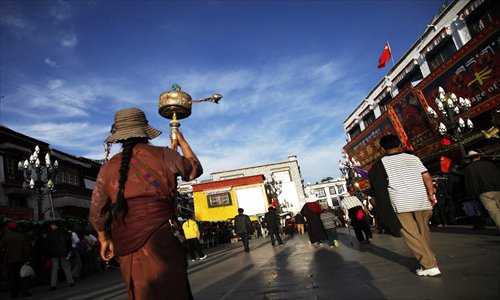A day out at Tibet-world

The forbidding peaks of Tibet have long been associated with remote journeys and spiritual purity, but few associate the mountainous region with theme parks.
A multi-billion dollar project launched by the local government aims to change this, but the scale of the investment, which would be a large drain on public finances, is raising eyebrows.
At a price tag of over 30 billion yuan ($4.76 billion) over the next five years, the plan, first announced by the Lhasa city government in the Tibet Autonomous Region in July, would consist of a "creative tourism base" that would occupy over eight square kilometers of land and be dedicated to Princess Wencheng of the Tang Dynasty (618-907).
Given the fact that the financial revenue of the Lhasa government was just 6.45 billion yuan in 2011, the investment represents a massive proportion of government revenue, according to reports in the China Economic Weekly, which also questioned the viability of such a large-scale project.
Questions have also been raised in the media regarding the potential environmental impacts as well as commercial influences on religious sites.
Culture on display
There are some locals, who are pleased to see that Princess Wencheng will feature as a cultural symbol at the theme park.
"Existing tourist sites such as the Potala Palace and Jokhang Temple are closely related to the princess. Tibetans respect her and it would be a great new tourist site if the park was established," Baima, a Tibetan tourist guide in Lhasa, told the Global Times.
He said he is confident that Lhasa will remain unique in the face of commercial operations, because religious beliefs that have accumulated over centuries will "purify" the area against any commercial malpractice.
The project will include attractions themed around Princess Wencheng, daughter of Emperor Li Shimin of the prosperous Tang Dynasty, who married Tibetan King Songtsan Gambo when she was 16. The princess, along with a dowry consisting of numerous treasures, books, golden furniture and medical equipment, traveled 3,000 kilometers to her new home.
The princess will be the focus of numerous performances at the park, where construction began in July.
"Our main purpose is to present the various cultures of Tibet at a one-stop theme park. Visitors can experience these cultures in Lhasa without having to travel far to other remote areas if their travel time is limited," said a government employee surnamed Zhao, who works for the department coordinating the outdoor performances.
Zhao told the Global Times the government is in charge of the preliminary development of the creative tourism base and will open bids to attract private investment into the project.
"Princess Wencheng will be the central focus, serving to drum up publicity for the theme park," Zhao said, adding that the local government is expecting to make profit from the project, but their main purpose is to show Tibetan culture to the world.
The culture and tourism park will also include an "Art City," home to displays of Tibetan handicrafts and medicine, and a "Folk City," where tourists can get a taste of local life and buy souvenirs.
Cultural innovation, business and residential districts will also be incorporated into the project, according to China Tibet Online.
Unrealistic expectations?
With doubts regarding the success of the project spreading online, experts said the size of the required investment might have been exaggerated.
"The government is in charge of the preliminary development stages and smaller, sub-projects will attract investment from companies. So Lhasa is not risking that much of its five-year financial revenues for the project. It would be impossible for a local government to risk that much for this kind of project," Liu Simin, a researcher with the Tourism Research Center at the Chinese Academy of Social Sciences, told the Global Times.
In recent years, local governments have often looked toward tourism projects as a way to attract both profit and attention toward their area. Results have been mixed.
Examples of success stories include the Happy Valley chain, which has parks in Beijing, Shenzhen, Chengdu and Shanghai. These parks received more than 10 million visitors in 2010 and the net profit of the Beijing Happy Valley park exceeded 100 million yuan in 2011, the China Economic Weekly reported.
However, there are also numerous examples of failed tourism projects littered throughout the Chinese countryside.
A derelict park entitled "Wonderland" in Beijing's Changping district has often been cited as an example of property bubbles within the Chinese market. The vast park has been abandoned, with bureaucratic entanglements and property disputes with farmers being cited as the chief causes.
Despite the fact that its incoming tourists and total revenue was increasing, the Hong Kong Disneyland still faced a $30 million loss in 2011, according to its fiscal report.
In terms of the Lhasa project, Liu isn't ruling anything out.
"As Lhasa becomes an international tourism city, it will inevitably embrace modern culture and a theme park is one of the options," Liu said. "But a theme park doesn't assure profits, as Lhasa is special geographically. In terms of tourist volume, it's hard to compete with mega cities such as Beijing and Shanghai."
"The outdoor performances will attract more tourists as attendance at night-time activities is increasing but whether a theme park or a creative tourism base will succeed is still in question," Liu said.